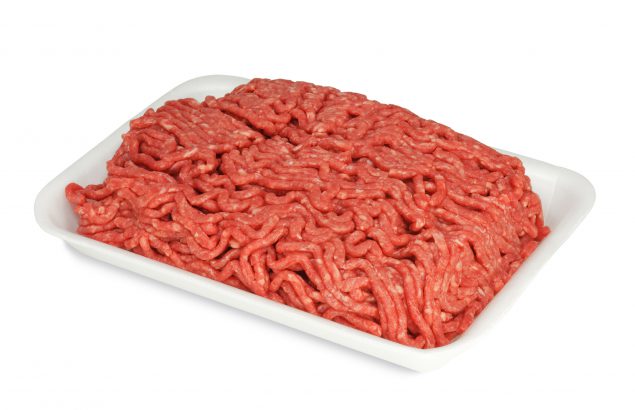CDC, several states, and the U.S. Department of Agriculture’s Food Safety and Inspection Service are investigating a multistate outbreak of Shiga toxin-producing Escherichia coli O103 infections linked to ground beef.

Restaurants, retailers, and institutions should not sell or serve the following recalled ground beef products because they may be contaminated with E. coli O103 and could make people sick:
Grant Park Packing in Franklin Park, Ill., recalledexternal icon approximately 53,200 pounds of raw ground beef products on April 24, 2019.
- Recalled products were sold in 40-lb. bulk cardboard boxes of “North Star Imports & Sales, LLC. 100% GROUND BEEF BULK 80% LEAN/ 20% FAT” marked “FOR INSTITUTIONAL USE ONLY” with lot code GP.1051.18 and pack dates 10/30/2018, 10/31/2018, and 11/01/2018.
- Recalled products are labeled with establishment number “EST. 21781” inside the USDA mark of inspection on the boxes.
K2D Foods, doing business as Colorado Premium Foods, in Carrollton, Ga., recalledexternal iconapproximately 113,424 pounds of raw ground beef products on April 23, 2019.
- Recalled products were sold in two 24-lb. vacuum-packed packages in cardboard boxes containing raw “GROUND BEEF PUCK” with “Use Thru” dates of 4/14/19, 4/17/19, 4/20/19, 4/23/19, 4/28/19, and 4/30/19.
- Recalled products are labeled with establishment number “EST. 51308” inside the USDA mark of inspection.
Ill people in this outbreak ate ground beef from many sources. Investigators continue to trace other sources for ground beef, and more product contaminated with E. coli O103 may be recalled.
Consumers and restaurants should always handle and cook ground beef safely to avoid foodborne illness. Thoroughly cook ground beef and any food that contains ground beef to kill germs. Never eat, serve, or sell recalled ground beef.
Wash hands with soap and water after touching raw ground beef. Use hot, soapy water or a bleach solution to wash kitchen items that touched raw meat.
- Handling ground beef:
- Keep raw meat separate from foods that won’t be cooked before eating.
- Wash hands with soap and water after touching raw meat and before touching other kitchen items.
- Thoroughly wash countertops, cutting boards, plates, and utensils with hot, soapy water or a bleach solution after they touch raw meat to avoid contaminating other foods and items in your kitchen.
- Cooking ground beef:
- Don’t eat raw or undercooked ground beef.
- Cook ground beef hamburgers and mixtures such as meatloaf to 160°F internal temperature. Use a food thermometerexternal icon to make sure the meat has reached a safe internal temperature. You can’t tell whether meat is safely cooked by looking at it.
- For hamburgers, insert thermometer through the side of the patty until it reaches the middle.
- For foods like meatloaf place the thermometer in the thickest part of the meat.
- For casseroles and for sauces that contain ground beef, such as spaghetti sauce or sloppy joe, check the temperature in several places.
- After cooking ground beef, refrigerate within 2 hours and use within 3 to 4 days.
- When ordering at a restaurant, ask that ground beef hamburgers and mixtures be cooked to an internal temperature of at least 160°F.
- Storing ground beef:
- Refrigerate or freeze raw ground beef within two hours after purchase.
- If you refrigerate raw ground beef, use within 1 or 2 days.
- Store ground beef in a plastic bag on the lowest shelf of your refrigerator.
- If you break large packages of ground beef into smaller packages for freezing:
- Wash hands with soap and water after touching the meat or its packaging, and before touching other surfaces.
- Use hot, soapy water to clean the area where you divided the ground beef, including kitchen counters and utensils.
- Label your packages with the date they were placed in the freezer and where you purchased the ground beef.
- Thawing ground beef:
- The best way to safely thaw ground beef is in the refrigerator. Cook or refreeze within 1 or 2 days.
- After thawing raw ground beef in the refrigerator, cook it before refreezing.
For more information about how to handle ground beef safely, call the USDA Meat and Poultry Hotlineexternal icon at 1-888-MPHotline (1-888-674-6854).
Take action if you have symptoms of an E. coli infection:
- Talk to your healthcare provider.
- Write down what you ate in the week before you started to get sick.
- Report your illness to the health department.
- Assist public health investigators by answering questions about your illness.

- A total of 177 people infected with the outbreak strain of E. coli O103 have been reported from 10 states.
- Twenty-one people have been hospitalized. No cases of hemolytic uremic syndrome, a type of kidney failure, have been reported. No deaths have been reported.
- Epidemiologic and laboratory evidence indicates that ground beef is the likely source of this outbreak.
- Ill people in this outbreak report eating ground beef at home and in restaurants.
- E. coli O103 was identified in samples of ground beef collected from locations where ill people reported eating. Laboratory testing identified the outbreak strain in one of these ground beef samples.
- Traceback investigations are ongoing to determine the source of ground beef supplied to grocery stores and other locations where ill people reported eating.
- Two companies have recalled ground beef products that were sold to restaurants and institutions because they may be contaminated with E. coli O103.
- At this time, no common supplier, distributor, or brand of ground beef has been identified that could account for the whole outbreak. Other products may be recalled.
- Restaurants, retailers, and institutions should not sell or serve recalled ground beef.
- CDC recommends that consumers and restaurants always handle ground beef safely and cook it thoroughly to avoid foodborne illness.
- CDC will provide updates as more information becomes available.


